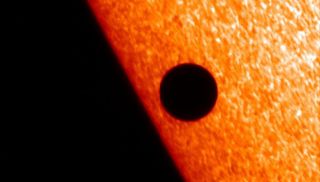On Monday (Nov. 11), Mercury will move across the sun's face and several spacecraft will have their sights set on the rare event.
Spacecraft have captured incredible images of past Mercury transits, and this year promises some exciting observations from space. NASA's Solar Dynamics Observatory (SDO) and Solar & Heliospheric Observatory (SOHO) will be watching the sun during Mercury's roughly 5.5-hour trip, and a Japanese mission may also provide a close-up glimpse.
On Earth, skygazers in North America, South America, Europe, Africa and even Antarctica can view the event using safe ISO-certified protective solar-viewing gear — weather permitting. Those in Alaska, the Pacific and Asia won't catch the event, because the sun will be below the horizon when Mercury passes in front of the star like a traveling blemish. Fortunately, the teams behind several space missions will be sharing unobstructed views of Mercury's transit.
Related: Mercury Transit 2019: Where and How to See It on Nov. 11

This image of the Mercury transit's final minutes was taken by NASA's Solar Dynamics Observatory on May 9, 2016, with its Atmospheric Imaging Assembly.
(Image credit: JAXA/NASA/PPARC)
SDO is designed to study changes in the sun's activity and how that influences Earth. Now in its ninth year orbiting our planet, SDO continues taking measurements of the sun's interior, magnetic field and the scorchingly hot outer atmosphere of the star, called the corona. Three scientific experiments on board SDO track these tidbits about the sun: the Atmospheric Imaging Assembly (AIA), the EUV Variability Experiment (EVE) and the Helioseismic and Magnetic Imager (HMI). In its lifetime, SDO's nearly round-the-clock coverage of the sun has produced over 350 million images and has been used in over 3,000 research papers, according to NASA.
A team from SDO will regularly update its website with the latest views of Mercury's Nov. 11 transit, accessible here starting at about 7 a.m. EST (1200 GMT), about half an hour before Mercury's first contact (when the planet's silhouette is tangent to the solar disk for the first time).
NASA also runs SOHO, a 12-instrument spacecraft built in collaboration with the European Space Agency. SOHO has been in space longer than SDO, having launched over two decades ago. It keeps regular tabs on the sun and produces several time-lapse views of the sun in gif-movie format. Like SDO, they are regularly updated on NASA's website. Mercury will likely appear in these views, albeit perhaps as a speeding spot in an accelerated time-lapse video. SOHO videos can be viewed here.

Japan's Hinode spacecraft captured this image of Mercury passing in front of the sun on Nov. 8, 2006, using the spacecraft's Solar Optical Telescope instrument.
(Image credit: JAXA/NASA/PPARC)
The Hinode solar-observing satellite, led by the Japan Aerospace Exploration Agency (JAXA), has caught great imagery of Mercury transits in the past. The mission team will publish images sometime after the Nov. 11 event, a NASA spokesperson told Space.com. (Hinode is also part of the Solar Terrestrial Probes Program within the Heliophysics Division of NASA's Science Mission Directorate in Washington.) The 13-year-old mission is equipped with three powerful telescopes that aid scientists in learning how solar phenomena like heating and magnetism affect the star's dramatic activity, like solar flares.
Hinode has also caught bigger shadows passing in front of the sun, like the Great American Solar Eclipse of 2017.
There are a few newer missions keeping an eye on the sun and Mercury. The joint European-Japanese BepiColombo mission launched last year and has already taken over 500 images (like this selfie) on its lengthy journey to reach Mercury. But it wasn't engineered to look at the sun, Erika Verbelen, an ESA spokesperson, told Space.com, so it will not see the solar transit on Monday.
NASA's Parker Solar Probe has the star's name right in its mission title, but at the moment its instruments are turned off. Even if they were turned on, which will happen when the probe is closer to the sun in its mission-outlined orbit, Parker Solar Probe isn't designed to take direct images of the sun, Karen C. Fox, a NASA spokesperson, told Space.com. Rather, it takes observations of the solar wind streaming off the sun.
Editor's Note: Visit Space.com on Nov. 11 to see live webcast views of the rare Mercury transit as shown from telescopes on Earth and in space, along with complete coverage of the celestial event. If you SAFELY capture a photo of the transit of Mercury and would like to share it with Space.com and our news partners for a story or gallery, you can send images and comments in to spacephotos@space.com.
Follow Doris Elin Urrutia on Twitter @salazar_elin. Follow us on Twitter @Spacedotcom and on Facebook.

Need more space? Subscribe to our sister title "All About Space" Magazine for the latest amazing news from the final frontier!
(Image credit: All About Space)
Bagikan Berita Ini














0 Response to "Mercury Transit 2019: How a Spacecraft Fleet Will Watch the Rare Event from Space - Space.com"
Post a Comment